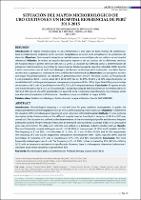Situación del mapeo microbiológico de urocultivos en un hospital referencial de Perú, 2013-2015.

Related Resource(s)
https://revistas.urp.edu.pe/index.php/RFMH/article/view/1268Date
2018Author(s)
Grandez-Urbina, J.Antonio
Pichardo-Rodriguez, Rafael
Corrales-Acosta, E.
Olórtegui, Rosmery
Valencia, Claudia
Pascual, Lucero
Vela- Ruiz, José M.
Vásquez-Quiroz, E.
Metadata
Show full item recordAlternate title
Situation of the microbiological mapping of urine cultures in a referral hospital of Peru 2013-2015
Abstract
El mapeo microbiológico es una herramienta y pilar para un buen manejo de antibióticos; es una guía los tratamientos empíricos en los servicios hospitalarios así como en la actualización de protocolos de atención. En el presente estudio se determina la situación actual del mapeo microbiológico de urocultivos en el Hospital Alberto Sabogal Sologuren. Se realizó un estudio descriptivo trasversal de urocultivos de los diferentes servicios del hospital desde el primer semestre del 2013 al 2015. La situación fue definida como la determinación de patógenos más frecuentes y porcentaje de resistencia por Betalactamasa de espectro extendido (BLEE) durante 3 años consecutivos más el perfil microbiológico del Servicio de Urología de la institución. Los datos fueron recolectados y agregados a una base de datos codificada en doble back up. El agente aislado con mayor frecuencia fue E. coli. La frecuencia de E. coli productoras de BLEE ha sufrido un incremento del 33 % (2013) al 50% para el año 2015, añadiéndose el aumento de la resistencia a ciprofloxacino. Sin embargo, existe una alternativa terapéutica (cefotaxima/ac. clavulanico) cuya sensibilidad es mayor al 90%. Introduction: Microbiological mapping is a tool and base for good antibiotic management. It guides the
empirical treatments in the hospital services as well as in the updating of care protocols. Objective: To determine
the situation of the microbiological mapping of urine cultures in referential hospital. Methods: A cross-sectional
descriptive study of urine cultures of the different hospital services from the first semester of 2013 to 2015 was
carried out. The situation was defined as the determination of the microbiological profile and the most frequent
pathogens isolated. The percentage of resistance by extended-spectrum beta-lactamase (ESBL) for 3 consecutive
years was determined. The data were collected and added to a database coded in double back up. Results:
The most frequently isolated pathogens were E. coli (56.60%), K. pneumoniae (10.12%) and P. mirabilis (4.22%).
The frequency of E. coli ESBL (+) in the years 2013, 2014, 2015 was 37.49%; 47.02% and 50.10% respectively.
The sensitivity of E. coli was for ertapenem, meropenem and imipenem (99% -100%), tigecillin (99%) and the
percentage of resistance of E. coli to Ciprofloxacin: 67%, 72% and 82% respectively. Conclusion: The most
frequently isolated agent was E. coli. The frequency of E. coli ESBL (+) has increased by 33% (2013) to 50% by
2015, with an increase in resistance to ciprofloxacin. However, there is a therapeutic alternative (cefotaxime /
clavulanic acid) whose sensitivity is greater than 90%.
Collections
- Artículos científicos [890]





